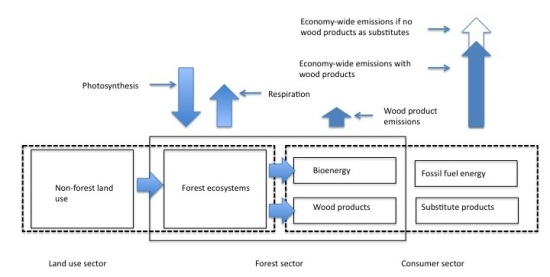Written by Bill Stewart, University of California Berkeley
The varying estimates of the role of tropical deforestation in the emission of greenhouse gasses have dwarfed the unique role that temperate forests play in mitigating the negative impacts of greenhouse gas additions to the atmosphere. In 2010, forest-related measurements for CO2 reduced the negative impacts from tropical deforestation and reaffirmed the large and growing carbon sink provided by managed temperate forests (Friedlingstein 2010).
Temperate forests have historically been well mapped and inventoried for the purpose of gauging the sustainability of the forests as sources of lumber, paper products, and energy while continuing to provide wildlife habitats, watershed protection, and open space for public recreation and enjoyment. After decades of heavy utilization, forests in both North America and Europe have been adding inventories while they have been managed to supply wood products. Even though metropolitan areas have grown into historically forested regions, many marginal agricultural fields have been transformed back into forests. In addition, improvements in seed stock and silvicultural techniques have increased productivity in many managed forests.
Climate change will affect tree species and forests very differently. Near the edges of the range of some species, it is probable that even slight changes in temperature and precipitation regimes will seriously alter the ability of trees to grow rapidly and reproduce successfully. Within forests with mixed species, it is probable that some species will expand while others contract. The total biomass productivity will increase with temperature in moist regions, but some of the species that contract may be the ones that are more valued by society. The rate of mortality may increase, but there will be considerable inertia before historic tree populations recede and new species that are better acclimated to future climates move in. The natural progression can be slow, and overall forest growth may be depressed as the growing space will be dominated by trees that are no longer optimally suited for the climate. Active management can be used to change the species composition more rapidly, but the question of how to balance historic, current, and potential future climate parameters will be a challenge to all reforestation managers.
From the point of view of overall emissions from all sectors, it is necessary to consider nonforest land use, forest ecosystems, and the consumer sector that uses both wood-based and nonwood-based products. All of these sectors have CO2 emissions, while it is only the forest ecosystem sector that is a net sink of carbon. Managing for overall reductions requires looking at the connections among the various sectors.

For forest management, two key issues are mitigation and adaptation. Mitigation is what needs to be done by the heavy emitters of greenhouse gas – mainly consumers and the major industries from which consumers purchase a wide range of emission-intensive products. U.S. forests and those of our major trading partners (Canada, Europe, and New Zealand) are all adding inventory at the same time that they are producing products that provide significant climate benefits compared to alternative products, such as cement and steel for construction and fuel oil and coal for energy. In the highly integrated trading network of countries with temperate forests, mitigation needs to increase the total forest-based carbon and not simply increase local forest carbon storage by reducing local harvest levels if they were sustainable to begin with.
New forests may take decades to mature, but more efficient management translate into more productive forests. Investments to initiate new forests, then, can increase both forest inventories and the output of wood products. Canada is the linchpin of the system because it provides an increasing share of wood products used in both the United States and Europe.
Adaptation in forest management will involve increasing the resilience of the forest system to address changes in growing conditions that can affect all plants and animals within the forest. In private and public forests that are managed to produce a sustainable supply of wood products, changes in species, silvicultural techniques, and harvesting patterns may be necessary to adjust to changing environmental conditions. In forests where the nonproduction aspects of the forest are more important, adaptation strategies will need to address a broader range of issues because many unique plants and animals may be adapted to unique conditions that are susceptible to slight changes in temperature, precipitation, and extreme weather events. It should also be noted that trees and forests respond to multiple stresses, including insects and diseases that may also be influenced by a changing climate. Coping with changes to forest health and species composition will require foresters to manage in the face of changing insect and disease dynamics, wildlife occurrence and severity, and the invasion of new plant species, some beneficial and others not.
References cited:
Friedlingstein, P., R.A. Houghton, G. Marland, J. Hackler, T.A. Boden, T.J. Conway, J.G. Canadell, M.R. Raupach, P. Ciais, and C. Le Quere. 2010. Update on CO2 emissions. Nature Geoscience. 3: 811-812.
Resources in this section:
- Interpreting Climate Data for Land Management
- Empirical Downscaling
- Scenario Planning
- Vulnerability Assessments
Also in Climate Change:
- Climate Variability and Change: Basic Concepts
- Climate Controls
- Past and Present Climate
- Basics of Climate Models
- Basics of Regional Climate Models
- Regional Climate Change Impacts from USGCRP
- Climate Change Assessments
